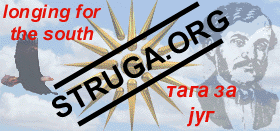
 |
Icons from Struga |
The physiognomy of the Macedo-Byzantine culture was formed within the vast internal and external dialogue with the "old" world which at times was rather dramatic. The process of reception of the Byzantine culture within the Macedonian environment successfully avoided the danger of mechanic mimesis and assimilation. During the miraculous processes of organic perichoresis, the Macedonian people developed their abilities in accordance to their own anthropological type, without departing from the historical "Byzantine" pattern.
It is the unique foundations, the essentially identical basis, and above all, the identical system of signs and the unique language of the image and the word, by means of which and through which the interaction with Byzantium was made possible, i.e. with everything that became an inseparable part of the early Byzantine epoch. It is exactly this early segment of the Byzantine culture that linked the Macedonian culture with the Greco-Roman civilization existing around the Mediterranean and with the heritage of the Jewish, Persian, Coptic, Syrian and other cultures of the near East.
Everything that had been received through the old forms of the Greek language, starting from the period of Cyril and Methodius and up to the formation of our own cultural centres in the period between the 12th and the 19th century, has become incorporated within the old Macedonian orthodox culture.
The roots of the Macedonian culture are deep and solid. They reach far into a synthesis which is an organic plethora including Rome with its idea or organization and sense of time, Athens with its philosophical and mystical heritage, and Jerusalem with its biblical historicism and messianism.
It is exactly in this context that we place the presented iconographic heritage of Struga. The iconological interpretation of this iconographic resort points at the mysterious contents written in the language of the anonymous painters of icons in the orthodox tradition. They invite us to anticipate the yearned-for sight of the radiant blessing from the Triune creation ex nihilo to become witnesses of the everlasting beauty created by the painter-poets. They talk to us vividly about the blessed effort of transforming art into a way of living, about the effort to solve all existential enigmas that arise from our ordinary life.
The liturgical painting of the Eastern Church in Macedonia reflects the wisdom of orthodox iconography. It is freed from the pietism and the exaltation as found in western naturalist art. According to the iconological exegesis, the wisdom embodied in the iconographic procedure of the orthodox painters surpasses the sensual spheres of passion and sentiment and penetrates the eternal light. It managed to free itself from the anthropomorphism of secular mysticism and expressed the triumph of Man's and God's realism over the pagan world view. The icon, therefore, understood as a "window to eternity", is neither an artistic photograph nor an artistic portrait. It simply does not aim at a naturalist and momentary presentation of an image.
Having also in mind that Macedonia has entered the wider ecumenical models of western culture, this, however partial presentation of the orthodox cultural heritage of Struga and its vicinity, becomes a foundation stone by means of which Macedonian people will come closer to that culture without fears of being assimilated by it or of surrendering its own identity to it.
Father Stefan Sandzhakoski